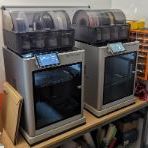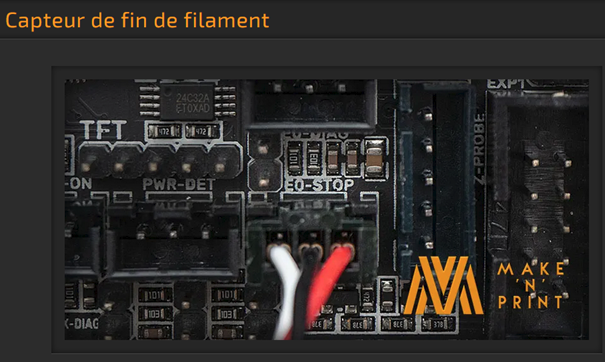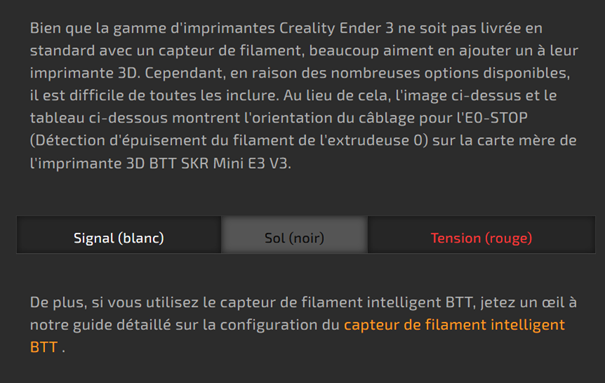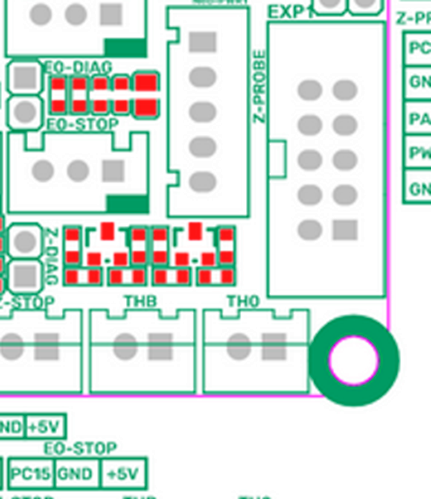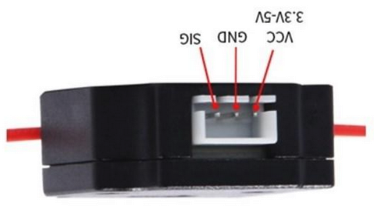
Avibrer
Membres-
Compteur de contenus
57 -
Inscrit(e) le
-
Dernière visite
Information
-
Imprimantes
Cr10 V2
SKR MINI E3 V3.0, TFT35 E3 V3.0
E3D V6
2xZ synchro, Cage
Marlin 2.1.2.1 (Stable), PrusaSlicer
Sécheur filament Créality
CLTouch origine Antclabs
Fin de course Créality
Visiteurs récents du profil
Récompenses de Avibrer
-
La température préconisée pour le plateau s'abaisse à 0
Avibrer en réponse au topic de Avibrer dans Entraide : Questions/Réponses sur l'impression 3D
Bonjour, Les problèmes d'arrêt d’impression n’ont pas disparus. Pour la pointe qui ne sortait plus, je l’ai redressée, pourquoi elle s’est tordue ? Je suppose que la chaleur peut être une cause possible. j’ai également réglé la vis aimantée. Je l’ai dévissée jusqu’à ce qu’elle soit au niveau du support, puis revissée d’un quart de tour. Mais j’ai constaté un autre défaut. Mais dernière interruption d’impression était dû à une coupure de courant. Mais pendant l’impression j’ai constaté que le BlTouch était éteint, seul un petit point rouge était visible. j’ai lancé une nouvelle impression et j’ai touché le seul connecteur qui se trouve sur la ligne d’alimentation. Il a un défaut. Donc j’ai commandé des fils 22 avg que je recevrai demain, je vais remplacer les fils d’alimentation depuis la carte SKR. Ai-je trouvé l’origine du problème qui empoisonne mes impressions ? On verra -
La température préconisée pour le plateau s'abaisse à 0
Avibrer en réponse au topic de Avibrer dans Entraide : Questions/Réponses sur l'impression 3D
Merci pour ceux qui sont intervenus. Vos remarques mon orientées vers d'autres options, j'ai observé l'imprimante. J'ai résolu mon problème. La pointe du BLTouch ne sortais plus, elle était tordue. -
La température préconisée pour le plateau s'abaisse à 0
Avibrer en réponse au topic de Avibrer dans Entraide : Questions/Réponses sur l'impression 3D
Merci pour la réponse Dans certains cas ce sont le plateau et la buse qui sont reprogrammées à 0. Cela plus de 4 ans que j'utilise Cura pour créer les g-code, j'ai imprimé plusieurs centaines d'heures de pièces. J'ai rencontré beaucoup de problèmes. C'est la 1er fois que j'ai ce cas. Mon imprimante est une CR10 V2 avec carte mère SKR Mini E3 V3, extrudeur de base Créality, Hotend E3D V6, BLTouch origine Ansclab, fin de course Créality. Merci pour ton aide -
Avibrer a commencé à suivre Détecteur fin de filament sur carte SKR MINI E3 V3.0 , La température préconisée pour le plateau s'abaisse à 0 , Nouveau extrudeur CR10V3 et 2 autres
-
Bonjour, Les thermistances de la buse et du plateau affichent la température de la pièce à la mise en route. Si je programme manuellement une température pour la buse et le plateau, elles restent en permanence constante. Si je lance une impression, le plateau atteint la température préconisée, puis la buse chauffe, la tête d'impression se déplace et attend que la température de la buse soit atteinte. Lorsque la température et atteinte, la température préconisée pour le plateau passe à 0, la température du plateau reste affichée. Il peu arriver que la buse affiche 0 pour la température souhaitée, la température atteinte par la buse reste affichée. J'ai testé l'impression d'objet avec des fichiers préparés par les slicer PrusaSlicer ou Cura, j’obtiens le même défaut. Comme panne j'exclus les thermistanes puisqu'elles affichent les températures de la buse et du plateau. Les résistances. Ai-je raison de m’orienter vers la carte mère : SKR Mini E3 V3 ? L'alimentation est neuve : 1 semaine environ. Si quelqu'un a une idée ? Merci
-
Blocage aléatoire de l'impression
Avibrer en réponse au topic de FredouilleA8 dans Entraide : Questions/Réponses sur l'impression 3D
Bonjour, si le moteur est à l’origine du problème, ce serait donc une utilisation dépassant ses capacités. Il me semble plausible que lui demander moins de mouvements doit permettre une impression réussit. Je dois préciser que dans ma recherche qui a aboutie à l’incrimination du moteur, j’ai changé : * la carte mère * l’alimentation * certain fils * testé Marlin 2.1.2.5 Votre démarche trouve un intérêt tout particulier chez moi. J’ai consacré beaucoup d’heures pour imprimer une pièce comme à l’origine. j’ai lu beaucoup d’avis et j’aimerai être conforté dans mon diagnostic. Ce qui me désole car je trouvais que la solution Hemera permet la suppression de nombreux problèmes, buse bouchée, remplacement simple de la buse, changement sans aucune difficulté du filament, mais voilà…. -
Blocage aléatoire de l'impression
Avibrer en réponse au topic de FredouilleA8 dans Entraide : Questions/Réponses sur l'impression 3D
Depuis plusieurs mois j'étais confronté au problème d'arrêt d'impression d'une pièce lorsqu'elle était importante. je viens de raconter mon expérience sur les avis d'Amazon. Voici ce que j'ai posté : "Mon imprimante est une C10 V2 modifié. J’ai commencé par installer un E3D V6. Puis un E3D direct Drive au mois de juillet 2021. Comme l’entretien devenait de plus en plus fréquent au mois d’août 2023, j’ai fait l’acquisition du Biqu H2 V2S Revo. Les problèmes d’ impression ont commencé. Pendant l’impression des pièces, le filament ne s’écoulait plus. Puis l’impression s’arrêtait. Au mois de mai 2024, Amazon me reprenait l’extruder Biqu H2 V2S Revo. En remplacement je faisais l’acquisition de l’extrudeur Hemera XS Revo. Les problèmes d’impression restaient identiques, c’est-à-dire que le filament ne s’écoulait plus et que l’impression s’arrêtait. Au mois de janvier 2024, remplacement de l’extrudeur Hemera par le même modèle. De nouveau pendant l’impression, le filament ne s’écoulait plus, puis l’imprimante s’arrêtait. J’ai retourné l’extrudeur, installé le bloc d’origine équipé du hotend E3D V6 en utilisant le principe bowden. Depuis je peux imprimer des pièces importantes sans difficulté." L'hypothèse qui me semble la plus plausible serait que pour réduire le poids l'extrudeur à entrainement direct, ils ont allégé les moteurs. Pourquoi cette hypothèse. Pendant 4 ans j'ai testé 5 extrudeurs, les seuls qui n'ont pas posé de problèmes ce sont les gros moteurs.(E3D Direct drive et le moteur de l'extrudeur déporté de Créality). Depuis ma nouvelle installation j'ai imprimé deux pièces avec une durée d'impression de 18 Heures chacunes, finition parfaite. Cela faisait des mois que cela était impossible pour moi. je viens de lancer une impression qui va durer une trentaine d'heures. -
Blocage aléatoire de l'impression
Avibrer en réponse au topic de FredouilleA8 dans Entraide : Questions/Réponses sur l'impression 3D
Bonjour, Est-il possible de connaitre le type d'extrudeur installé? -
Installer détecteur fin de filament Créality, carte SKR MINI E3 V3
Avibrer en réponse au topic de Avibrer dans Discussions sur les imprimantes 3D
Bonjour, J'ai chargé le firmware sans détecteur de fin de filament. Puis rechargé le firmware en changeant : #define FIL_RUNOUT_STATE LOW Effacer l'EEPROM Effectué les différentes calibrations. Mon 1er test s'est effectué avec succès, pas de message au démarrage, l'imprimante s'arrête en cas de fin de filament. -
Nouveau extrudeur CR10V3
Avibrer en réponse au topic de DreamZ MythiiZ dans Discussions sur les imprimantes 3D
J’ai une CR10 V2, j’ai installé l’extrudeur Hemera XS Revo il m’a permis de résoudre les problèmes : - L’entraînement et régulier et sans faille. - l’introduction d’un filament s’effectue très simplement, sans effort. - je n’ai plus de buse bouchée. -
mon imprimante n'imprime plus
Avibrer en réponse au topic de artemis037 dans Discussions sur les imprimantes 3D
Bonsoir, j’ai rencontré ce problème avec mon imprimante. Le filament s’écoulait de plus en plus difficilement et s’arrêtait. Extrudeur Biqu H2 V2S Revo j’ai fait plusieurs tests. Mon problème a trouvé sa solution par l’installation d’un nouvel extrudeur avec entraînement incorporé, le Hemera XS Revo. -
Bonjour, Il me reste à installer le détecteur de fin de filament de Créality. Je l’ai branché sans modifier le sens des fils. Si Firmware : #define FIL_RUNOUT_STATE LOW J’ai allumé l’imprimante, en présence de filment la led bleu est allumée, elle est éteinte en cas d’absence. La commande M119 affiche : Avec filament : Filament : TRIGGERED · Sans filament : Filament : open L’imprimante signale l’absence de filament (T0), la procédure de changement se poursuit jusqu’à son terme, puis l’absence de filament est de nouveau signalée et ceci sans fin. Si Firmware : #define FIL_RUNOUT_STATE HIGH J’ai allumé l’imprimante, en présence de filament la led bleu est allumée, elle est éteinte en cas d’absence. L’imprimante signale l’absence de filament (T0) au démarrage, puis imprime normalement. En fin de filament la led s’éteint mais l’imprimante ne s’arrête pas. J’ai précisé ci-dessous la configuration que j’utilise et qui ne fonctionne pas. Je dois préciser que je n’ai jamais réussi à faire fonctionner le détecteur de fin de filament Créality avec la carte SKR MINI E3 V3. Je remercie par avance les membres du forum. Connection SKR MINI E3 V3 Fin de filament Créality Firmware Marlin 2.1.2.1 Marlin\src\pins\ramps\pins_RAMPS_CREALITY.h: #define FIL_RUNOUT_PIN 15 #if NUM_RUNOUT_SENSORS >= 2 #define FIL_RUNOUT2_PIN 15 // Creality CR-X can use dual runout sensors #endif Configuration.h #define FILAMENT_RUNOUT_SENSOR #if ENABLED(FILAMENT_RUNOUT_SENSOR) #define FIL_RUNOUT_ENABLED_DEFAULT true // Enable the sensor on startup. Override with M412 followed by M500. #define NUM_RUNOUT_SENSORS 1 // Number of sensors, up to one per extruder. Define a FIL_RUNOUT#_PIN for each. #define FIL_RUNOUT_STATE HIGH // Pin state indicating that filament is NOT present.(LOW ou HIGH) #define FIL_RUNOUT_PULLUP // Use internal pullup for filament runout pins. //#define FIL_RUNOUT_PULLDOWN // Use internal pulldown for filament runout pins. //#define WATCH_ALL_RUNOUT_SENSORS // Execute runout script on any triggering sensor, not only for the active extruder. // This is automatically enabled for MIXING_EXTRUDERs. // Override individually if the runout sensors vary //#define FIL_RUNOUT1_STATE LOW //#define FIL_RUNOUT1_PULLUP //#define FIL_RUNOUT1_PULLDOWN //#define FIL_RUNOUT2_STATE LOW //#define FIL_RUNOUT2_PULLUP //#define FIL_RUNOUT2_PULLDOWN //#define FIL_RUNOUT3_STATE LOW //#define FIL_RUNOUT3_PULLUP //#define FIL_RUNOUT3_PULLDOWN //#define FIL_RUNOUT4_STATE LOW //#define FIL_RUNOUT4_PULLUP //#define FIL_RUNOUT4_PULLDOWN //#define FIL_RUNOUT5_STATE LOW //#define FIL_RUNOUT5_PULLUP //#define FIL_RUNOUT5_PULLDOWN //#define FIL_RUNOUT6_STATE LOW //#define FIL_RUNOUT6_PULLUP //#define FIL_RUNOUT6_PULLDOWN //#define FIL_RUNOUT7_STATE LOW //#define FIL_RUNOUT7_PULLUP //#define FIL_RUNOUT7_PULLDOWN //#define FIL_RUNOUT8_STATE LOW //#define FIL_RUNOUT8_PULLUP //#define FIL_RUNOUT8_PULLDOWN // Commands to execute on filament runout. // With multiple runout sensors use the %c placeholder for the current tool in commands (e.g., "M600 T%c") // NOTE: After 'M412 H1' the host handles filament runout and this script does not apply. #define FILAMENT_RUNOUT_SCRIPT "M600" // After a runout is detected, continue printing this length of filament // before executing the runout script. Useful for a sensor at the end of // a feed tube. Requires 4 bytes SRAM per sensor, plus 4 bytes overhead. // #define FILAMENT_RUNOUT_DISTANCE_MM 25 #ifdef FILAMENT_RUNOUT_DISTANCE_MM // Enable this option to use an encoder disc that toggles the runout pin // as the filament moves. (Be sure to set FILAMENT_RUNOUT_DISTANCE_MM // large enough to avoid false positives.) #define FILAMENT_MOTION_SENSOR #endif #endif Configuration.adv.h #define ADVANCED_PAUSE_FEATURE #if ENABLED(ADVANCED_PAUSE_FEATURE) #define PAUSE_PARK_RETRACT_FEEDRATE 60 // (mm/s) Initial retract feedrate. #define PAUSE_PARK_RETRACT_LENGTH 6 // (mm) Initial retract. // This short retract is done immediately, before parking the nozzle. #define FILAMENT_CHANGE_UNLOAD_FEEDRATE 10 // (mm/s) Unload filament feedrate. This can be pretty fast. #define FILAMENT_CHANGE_UNLOAD_ACCEL 25 // (mm/s^2) Lower acceleration may allow a faster feedrate. #define FILAMENT_CHANGE_UNLOAD_LENGTH 30 // (mm) The length of filament for a complete unload. // For Bowden, the full length of the tube and nozzle. // For direct drive, the full length of the nozzle. // Set to 0 for manual unloading. #define FILAMENT_CHANGE_SLOW_LOAD_FEEDRATE 6 // (mm/s) Slow move when starting load. #define FILAMENT_CHANGE_SLOW_LOAD_LENGTH 0 // (mm) Slow length, to allow time to insert material. // 0 to disable start loading and skip to fast load only #define FILAMENT_CHANGE_FAST_LOAD_FEEDRATE 6 // (mm/s) Load filament feedrate. This can be pretty fast. #define FILAMENT_CHANGE_FAST_LOAD_ACCEL 25 // (mm/s^2) Lower acceleration may allow a faster feedrate. #define FILAMENT_CHANGE_FAST_LOAD_LENGTH 6 // (mm) Load length of filament, from extruder gear to nozzle. // For Bowden, the full length of the tube and nozzle. // For direct drive, the full length of the nozzle. //#define ADVANCED_PAUSE_CONTINUOUS_PURGE // Purge continuously up to the purge length until interrupted. #define ADVANCED_PAUSE_PURGE_FEEDRATE 3 // (mm/s) Extrude feedrate (after loading). Should be slower than load feedrate. #define ADVANCED_PAUSE_PURGE_LENGTH 0 // (mm) Length to extrude after loading. // Set to 0 for manual extrusion. // Filament can be extruded repeatedly from the Filament Change menu // until extrusion is consistent, and to purge old filament. #define ADVANCED_PAUSE_RESUME_PRIME 0 // (mm) Extra distance to prime nozzle after returning from park. //#define ADVANCED_PAUSE_FANS_PAUSE // Turn off print-cooling fans while the machine is paused. // Filament Unload does a Retract, Delay, and Purge first: #define FILAMENT_UNLOAD_PURGE_RETRACT 13 // (mm) Unload initial retract length. #define FILAMENT_UNLOAD_PURGE_DELAY 5000 // (ms) Delay for the filament to cool after retract. #define FILAMENT_UNLOAD_PURGE_LENGTH 8 // (mm) An unretract is done, then this length is purged. #define FILAMENT_UNLOAD_PURGE_FEEDRATE 25 // (mm/s) feedrate to purge before unload #define PAUSE_PARK_NOZZLE_TIMEOUT 45 // (seconds) Time limit before the nozzle is turned off for safety. #define FILAMENT_CHANGE_ALERT_BEEPS 2 // Number of alert beeps to play when a response is needed. #define PAUSE_PARK_NO_STEPPER_TIMEOUT // Enable for XYZ steppers to stay powered on during filament change. //#define FILAMENT_CHANGE_RESUME_ON_INSERT // Automatically continue / load filament when runout sensor is triggered again. //#define PAUSE_REHEAT_FAST_RESUME // Reduce number of waits by not prompting again post-timeout before continuing. #define PARK_HEAD_ON_PAUSE // Park the nozzle during pause and filament change. #define HOME_BEFORE_FILAMENT_CHANGE // If needed, home before parking for filament change #define FILAMENT_LOAD_UNLOAD_GCODES // Add M701/M702 Load/Unload G-codes, plus Load/Unload in the LCD Prepare menu. //#define FILAMENT_UNLOAD_ALL_EXTRUDERS // Allow M702 to unload all extruders above a minimum target temp (as set by M302) #endif
-
Détecteur fin de filament sur carte SKR MINI E3 V3.0
Avibrer en réponse au topic de Avibrer dans Discussions sur les imprimantes 3D
Merci beaucoup pommeverte pour ta réponse. J’effectuerai le transfert des modifications sur mon imprimante dans deux ou trois Jours. Je copie ci-dessous les modifications que j’ai apportées. J’aurais bien aimé comprendre pourquoi les détecteurs ne fonctionnent pas sur la carte SKR MINI E3 V3, enfin peut-être un jour …. Je reviendrai pour communiquer les résultats de mes modifications. Encore merci beaucoup Fichier « configuration.h » // #define FILAMENT_RUNOUT_SENSOR Fichier « Config.ini » #-------------------------------------------------------------------- # NOTES for users having a filament sensor connected to the mainboard: # 1) Define "fil_runout:0" below to disable the sensor handling on the TFT. # 2) Configure the sensor in the firmware of your mainboard. # 3) Add M75 to "start_gcode" and M77 to "end_gcode" of the TFT (or your slicer). #### Filament Runout Sensor V3 # Select the type of filament runout sensor and its default enabled/disabled state. # Options: [Normal Disabled: 0, Normal Enabled: 1, Smart Disabled: 2, Smart Enabled: 3] fil_runout:3 #### Inverted Filament Runout Sensor Logic # The sensor uses an inverted logic. # Disable it in case filament runout is triggered by a LOW signal. # Enable it in case filament runout is triggered by a HIGH signal. # Options: [disable: 0, enable: 1] fil_runout_inverted:0 #### NC (Normal Close) Filament Runout Sensor # The sensor is of type NC. # Options: [Normal Open: 0, Normal Close: 1] fil_runout_nc:1 #### Filament Runout Noise Threshold # Pause print when filament runout is detected at least for this time period. # Unit: [time in milliseconds] # Value range: [min: 10, max: 1800] fil_runout_noise_threshold:100 #### Smart Filament Runout Detection # Used in conjunction with an SFS (Smart Filament Sensor) based on an encoder disc that # toggles runout pin as filament moves. # Unit: [distance in mm] # Value range: [min: 1, max: 50] fil_runout_distance:7 Fichier « Gcode » J’ai supprimé : les M75 et M77 des gcodes de démarrage et de fin du trancheur -
Détecteur fin de filament sur carte SKR MINI E3 V3.0
Avibrer en réponse au topic de Avibrer dans Discussions sur les imprimantes 3D
Bonjour, Avec le config.ini configuré comme ci-dessous, le détecteur de filament ne transmet pas d'information avec ou sans filament. #-------------------------------------------------------------------- # Filament Runout Settings (only if connected to TFT controller) #-------------------------------------------------------------------- # NOTES for users having a filament sensor connected to the mainboard: # 1) Define "fil_runout:0" below to disable the sensor handling on the TFT. # 2) Configure the sensor in the firmware of your mainboard. # 3) Add M75 to "start_gcode" and M77 to "end_gcode" of the TFT (or your slicer). #### Filament Runout Sensor # Select the type of filament runout sensor and its default enabled/disabled state. # Options: [Normal Disabled: 0, Normal Enabled: 1, Smart Disabled: 2, Smart Enabled: 3] fil_runout:0 #### Inverted Filament Runout Sensor Logic # The sensor uses an inverted logic. # Disable it in case filament runout is triggered by a LOW signal. # Enable it in case filament runout is triggered by a HIGH signal. # Options: [disable: 0, enable: 1] fil_runout_inverted:0 #### NC (Normal Close) Filament Runout Sensor # The sensor is of type NC. # Options: [Normal Open: 0, Normal Close: 1] fil_runout_nc:1 #### Filament Runout Noise Threshold # Pause print when filament runout is detected at least for this time period. # Unit: [time in milliseconds] # Value range: [min: 10, max: 1800] fil_runout_noise_threshold:100 #### Smart Filament Runout Detection # Used in conjunction with an SFS (Smart Filament Sensor) based on an encoder disc that # toggles runout pin as filament moves. # Unit: [distance in mm] # Value range: [min: 1, max: 50] fil_runout_distance:7 -
Détecteur fin de filament sur carte SKR MINI E3 V3.0
Avibrer a posté un sujet dans Discussions sur les imprimantes 3D
Mon imprimante est une Créality CR10 V2. Sa configuration actuelle est la suivante : · Détecteur de fin de filament (Contacteur d’origine) · 2xZ synchro, · Cage · E3D Titan direct Drive, · E3D V6 (Original) · SKR MINI E3 V2.0, puis SKR MINI E3 V3.0 · TFT35 E3 V3.0 · Marlin 2.0.9.3 (Stable), · Cura Depuis le remplacement de la carte mère d’origine, la Céality V2.5.2 par une carte SKR, le détecteur de fin de filament est inopérant. J’ai parcouru le forum et il me semble qu’il est possible de le faire fonctionner, actuellemnt c’est un échec, je vais préciser ci-dessous ma configuration. Carte SKR MINI E3 V3.0 Je n’ai pas modifier le câblage d’origine, je l’ai branché sur le connecteur « EO.STOP » Le test « M119 » affiche les résultats suivants : · Avec filament : Filament : TRIGGERED · Sans filament : Filament : open Configuration du firmware : « Configuration.h » #define FILAMENT_RUNOUT_SENSOR #if ENABLED(FILAMENT_RUNOUT_SENSOR) #define FIL_RUNOUT_ENABLED_DEFAULT true // Enable the sensor on startup. Override with M412 followed by M500. #define NUM_RUNOUT_SENSORS 1 // Number of sensors, up to one per extruder. Define a FIL_RUNOUT#_PIN for each. #define FIL_RUNOUT_STATE LOW // Pin state indicating that filament is NOT present. #define FIL_RUNOUT_PULLUP // Use internal pullup for filament runout pins. //#define FIL_RUNOUT_PULLDOWN // Use internal pulldown for filament runout pins. //#define WATCH_ALL_RUNOUT_SENSORS // Execute runout script on any triggering sensor, not only for the active extruder. // This is automatically enabled for MIXING_EXTRUDERs. // Override individually if the runout sensors vary //#define FIL_RUNOUT1_STATE LOW //#define FIL_RUNOUT1_PULLUP //#define FIL_RUNOUT1_PULLDOWN //#define FIL_RUNOUT2_STATE LOW //#define FIL_RUNOUT2_PULLUP //#define FIL_RUNOUT2_PULLDOWN //#define FIL_RUNOUT3_STATE LOW //#define FIL_RUNOUT3_PULLUP //#define FIL_RUNOUT3_PULLDOWN //#define FIL_RUNOUT4_STATE LOW //#define FIL_RUNOUT4_PULLUP //#define FIL_RUNOUT4_PULLDOWN //#define FIL_RUNOUT5_STATE LOW //#define FIL_RUNOUT5_PULLUP //#define FIL_RUNOUT5_PULLDOWN //#define FIL_RUNOUT6_STATE LOW //#define FIL_RUNOUT6_PULLUP //#define FIL_RUNOUT6_PULLDOWN //#define FIL_RUNOUT7_STATE LOW //#define FIL_RUNOUT7_PULLUP //#define FIL_RUNOUT7_PULLDOWN //#define FIL_RUNOUT8_STATE LOW //#define FIL_RUNOUT8_PULLUP //#define FIL_RUNOUT8_PULLDOWN // Commands to execute on filament runout. // With multiple runout sensors use the %c placeholder for the current tool in commands (e.g., "M600 T%c") // NOTE: After 'M412 H1' the host handles filament runout and this script does not apply. #define FILAMENT_RUNOUT_SCRIPT "M600" // After a runout is detected, continue printing this length of filament // before executing the runout script. Useful for a sensor at the end of // a feed tube. Requires 4 bytes SRAM per sensor, plus 4 bytes overhead. #define FILAMENT_RUNOUT_DISTANCE_MM 7 #ifdef FILAMENT_RUNOUT_DISTANCE_MM // Enable this option to use an encoder disc that toggles the runout pin // as the filament moves. (Be sure to set FILAMENT_RUNOUT_DISTANCE_MM // large enough to avoid false positives.) #define FILAMENT_MOTION_SENSOR #endif #endif « Configuration_adv.h » #define ADVANCED_PAUSE_FEATURE #if ENABLED(ADVANCED_PAUSE_FEATURE) #define PAUSE_PARK_RETRACT_FEEDRATE 60 // (mm/s) Initial retract feedrate. #define PAUSE_PARK_RETRACT_LENGTH 2 // (mm) Initial retract. // This short retract is done immediately, before parking the nozzle. #define FILAMENT_CHANGE_UNLOAD_FEEDRATE 10 // (mm/s) Unload filament feedrate. This can be pretty fast. #define FILAMENT_CHANGE_UNLOAD_ACCEL 25 // (mm/s^2) Lower acceleration may allow a faster feedrate. #define FILAMENT_CHANGE_UNLOAD_LENGTH 70 // (mm) The length of filament for a complete unload. // For Bowden, the full length of the tube and nozzle. // For direct drive, the full length of the nozzle. // Set to 0 for manual unloading. #define FILAMENT_CHANGE_SLOW_LOAD_FEEDRATE 6 // (mm/s) Slow move when starting load. #define FILAMENT_CHANGE_SLOW_LOAD_LENGTH 0 // (mm) Slow length, to allow time to insert material. // 0 to disable start loading and skip to fast load only #define FILAMENT_CHANGE_FAST_LOAD_FEEDRATE 60 // (mm/s) Load filament feedrate. This can be pretty fast. #define FILAMENT_CHANGE_FAST_LOAD_ACCEL 25 // (mm/s^2) Lower acceleration may allow a faster feedrate. #define FILAMENT_CHANGE_FAST_LOAD_LENGTH 70 // (mm) Load length of filament, from extruder gear to nozzle. // For Bowden, the full length of the tube and nozzle. // For direct drive, the full length of the nozzle. //#define ADVANCED_PAUSE_CONTINUOUS_PURGE // Purge continuously up to the purge length until interrupted. #define ADVANCED_PAUSE_PURGE_FEEDRATE 3 // (mm/s) Extrude feedrate (after loading). Should be slower than load feedrate. #define ADVANCED_PAUSE_PURGE_LENGTH 50 // (mm) Length to extrude after loading. // Set to 0 for manual extrusion. // Filament can be extruded repeatedly from the Filament Change menu // until extrusion is consistent, and to purge old filament. #define ADVANCED_PAUSE_RESUME_PRIME 0 // (mm) Extra distance to prime nozzle after returning from park. //#define ADVANCED_PAUSE_FANS_PAUSE // Turn off print-cooling fans while the machine is paused. // Filament Unload does a Retract, Delay, and Purge first: #define FILAMENT_UNLOAD_PURGE_RETRACT 13 // (mm) Unload initial retract length. #define FILAMENT_UNLOAD_PURGE_DELAY 5000 // (ms) Delay for the filament to cool after retract. #define FILAMENT_UNLOAD_PURGE_LENGTH 8 // (mm) An unretract is done, then this length is purged. #define FILAMENT_UNLOAD_PURGE_FEEDRATE 25 // (mm/s) feedrate to purge before unload #define PAUSE_PARK_NOZZLE_TIMEOUT 45 // (seconds) Time limit before the nozzle is turned off for safety. #define FILAMENT_CHANGE_ALERT_BEEPS 10 // Number of alert beeps to play when a response is needed. #define PAUSE_PARK_NO_STEPPER_TIMEOUT // Enable for XYZ steppers to stay powered on during filament change. //#define FILAMENT_CHANGE_RESUME_ON_INSERT // Automatically continue / load filament when runout sensor is triggered again. //#define PAUSE_REHEAT_FAST_RESUME // Reduce number of waits by not prompting again post-timeout before continuing. #define PARK_HEAD_ON_PAUSE // Park the nozzle during pause and filament change. #define HOME_BEFORE_FILAMENT_CHANGE // If needed, home before parking for filament change #define FILAMENT_LOAD_UNLOAD_GCODES // Add M701/M702 Load/Unload G-codes, plus Load/Unload in the LCD Prepare menu. //#define FILAMENT_UNLOAD_ALL_EXTRUDERS // Allow M702 to unload all extruders above a minimum target temp (as set by M302) #endif « Pins_BTT_SKR_MINI_E3_V_0.h » // // Filament Runout Sensor // #ifndef FIL_RUNOUT_PIN #define FIL_RUNOUT_PIN PC15 // E0-STOP #endif FIL_RUNOUT_PIN PC15 s’exécute si la condition « FIL_RUNOUT_PIN » est satisfaite. Je n’ai pas trouvé comment ni où le contrôler. « Config.ini pour BTT TFT35 V3.0 » #-------------------------------------------------------------------- # Filament Runout Settings (only if connected to TFT controller) #-------------------------------------------------------------------- # NOTES for users having a filament sensor connected to the mainboard: # 1) Define "fil_runout:0" below to disable the sensor handling on the TFT. # 2) Configure the sensor in the firmware of your mainboard. # 3) Add M75 to "start_gcode" and M77 to "end_gcode" of the TFT (or your slicer). #### Filament Runout Sensor # Select the type of filament runout sensor and its default enabled/disabled state. # Options: [Normal Disabled: 0, Normal Enabled: 1, Smart Disabled: 2, Smart Enabled: 3] fil_runout:3 #### Inverted Filament Runout Sensor Logic # The sensor uses an inverted logic. # Disable it in case filament runout is triggered by a LOW signal. # Enable it in case filament runout is triggered by a HIGH signal. # Options: [disable: 0, enable: 1] fil_runout_inverted:0 #### NC (Normal Close) Filament Runout Sensor # The sensor is of type NC. # Options: [Normal Open: 0, Normal Close: 1] fil_runout_nc:1 #### Filament Runout Noise Threshold # Pause print when filament runout is detected at least for this time period. # Unit: [time in milliseconds] # Value range: [min: 10, max: 1800] fil_runout_noise_threshold:100 #### Smart Filament Runout Detection # Used in conjunction with an SFS (Smart Filament Sensor) based on an encoder disc that # toggles runout pin as filament moves. # Unit: [distance in mm] # Value range: [min: 1, max: 50] fil_runout_distance:7 Paramètres M75 et M77 dans gcode G-code de démarrage M75 M201 X500.00 Y500.00 Z100.00 E5000.00 ;Setup machine max acceleration M203 X500.00 Y500.00 Z10.00 E50.00 ;Setup machine max feedrate M204 P500.00 R1000.00 T500.00 ;Setup Print/Retract/Travel acceleration M205 X8.00 Y8.00 Z0.40 E5.00 ;Setup Jerk M220 S100 ;Reset Feedrate M221 S100 ;Reset Flowrate G-code de fin M104 S0 ;Turn-off hotend M140 S0 ;Turn-off bed M77 M84 X Y E ;Disable all steppers but Z L’Eeprom, de l’imprimante est réinitialisée. Conclusion : L’imprimante commence par détecter une fin de filament au démarrage avec ou sans filament, puis plus aucune détection en cas de fin de filament. Si quelqu’un peut m’orienter sur l’erreur qui se trouve sur ma configuration, merci. Je possède le capteur de filament Bigtreetech. (Il ne fonctionnement pas sur la carte) Je vais tester la solution du branchement sur le TFT35 E3 V3. -
Installer SKR MINI E3V3 dans CR10 V2
Avibrer en réponse au topic de Avibrer dans Discussions sur les imprimantes 3D
Bonjour, Je reviens sur la ventilation du filament. J'ai reçu deux ventilateurs, prix 60€ ! (Amazon) Caractéristiques : " Lot de 2 ventilateurs de refroidissement sans balais 24 V CC 50 x 50 x 15 mm * Double roulement à billes, longue durée de vie : 70 000 heures à 40 °C. * Qualité professionnelle, certifié UL. * Tension : 24 V - Vitesse : 6000 tr/min - Courant : 0,18 A - Débit d'air : 4,24 CFM - Bruit : 43 dB-A - Longueur du câble : 20 cm. * Remplacement pour imprimante 3D, ordinateur ou autres petits appareils " Je constate qu'il commence à tourne avec certitude à 25 %, puis il est possible de le régler jusqu'à 12%. Très silencieux à 30% J'ai choisie l'option de l'assurance de 2 ans supplémentaire pour 1,70€. Je vais essayer de récapituler dans un prochain message les documents que j'ai posté.


